The Dream Coach by Anne Parrish (illustrated by Dillwyn Parrish; Macmillan, 1924) is a collection of a poem and four stories that are named the dreams of four children around the world. The children include a princess, a boy from Norway, a young Chinese boy “emperor,” and a French boy in the countryside. Each story is framed as a “trip” in the Dream Coach. As is often the case with short story collections, the stories here are uneven and although the book is okay overall, along with the sugary-sweet poem and subtle racism in two of the stories, it is a book I’d hesitate to hand to children today.
The book begins with a poem about the “Dream Coach” and it is so cringe-worthy that I dreaded what was coming in this volume. The rhyming was stilted, the imagery of a coach dancing in the clouds was painfully “sweet” and the entire concept seemed almost offensive to many children simply because it was so far below a child’s sensitivities.
The first story, “The Seven White Dreams of the King’s Little Daughter,” felt much the same in terms of sappiness, although it was a relief that the author stopped trying to write in poetic rhyme. In the first story, the princess’s day is described, ending with the image of her falling asleep and the sweet dreams that made up for the boring day. This story described her day, which happened to be her birthday, going from one grown-up event to another. (As for one of the problematic issues, at one point, the princess walked along in a huge procession of palace workers, including “four gigantic blacks.”) Her day end with her early bedtime while the grown-ups celebrated her birthday with a fantastic ball. The angels all see her cry herself to sleep and all feel sad for her,
So that by the time the little angel was ready to start to earth there were seven white dreams to be taken as birthday gifts from Heaven, and he had to weave a basket of moonbeams to carry them in.
Then the reader can hear of her six sweet little dreams (one was lost), but the story of her day felt far longer than these dreams, so they felt completely overshadowed in my opinion.
The second story was my favorite, and it is such that I can almost see it being altered slightly and republished as a short story of it’s own. In “Goran’s Dream,” the young Norwegian boy Goran (who is six years old) is left alone for one night while his grandmother travels to do shopping in a distant place away from their fjord. He is very sad, but he has his goat and chicken to care for, as well as the need to wind the clock. He also finds a playing card, a Queen, which he props up to be his dinner guest, and then he makes a snowman before the sun goes down. As he falls asleep, the queen grows to normal size, the snowman comes in to play, the clock ticks (and tries to remind Goran to wind him up!) and the goat and chicken have an adventurous evening. I loved the creativity and the weaving into the story of the dream. The reader doesn’t quite know when the dream began and it makes it a lot of fun.
“A Bird Cage With Tassels of Purple and Pearls,” the third story in the collection, retells the story of “The Emperor and the Nightingale,” without calling it that and without referring to the bird the little emperor imprisons as a nightingale. Similar to the folk tale, the boy captures a bird to hear it’s singing, but it does not sing anymore, even with a lovely cage. It is in his dream, when the boy finds himself trapped in a cage, that his heart is softened and he decides to let his bird be freed.
The last story, “‘King’ Philippe’s Dream,” was an average story, this time about a young boy in the French countryside. I really liked the dream sequence but the introduction, in which his mother gives him a scrubbing in a washtub, felt unnecessarily long. In the pre-dream portion, he learns about his traveling uncle who is coming to grandfather’s house. The parents are particularly concerned that Philippe be on his best behavior in front of the uncle, in hopes of someday getting favors from him. Philippe travels to his grandfather’s house and meets his teary-eyed grandmother, unfriendly and cold grandfather, his sweet little cousin, and his friendly and pompous uncle. After some visiting, he does fall asleep under the table, and he dreams of his uncle (whom his parents mentioned “I think, for that matter, that he is a little inclined to blow”) as the wind, his grandmother as the rain, his uncle like snow, and his little cousin as a princess, while he is the king. He has adventures in the weather, and the sequence is quite imaginative.
As I mentioned, as a whole the book doesn’t quite add up to a success for me, but it was not written for today’s children. The Dream Coach was awarded a Newbery Honor in 1925, and I do see the creativity. I’m sure some children did appreciate the creative dreams these children enjoyed, and maybe they liked to tell of their own imaginative dreams they had as a result of reading this classic bedtime story one hundred years ago.
I rate The Dream Coach Newbery Honor as “okay” and say “maybe if you have time.”
Newbery rating scale: FANTASTIC | REALLY GOOD | PRETTY GOOD | OKAY | BLAH
What to do with this Newbery: KEEP IT AND READ IT | MAYBE IF YOU HAVE TIME | DON’T BOTHER





